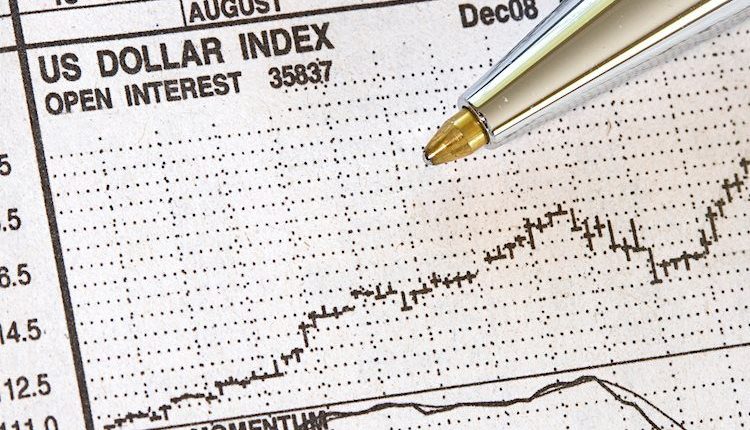- The US Dollar struggles to find demand at the end of the week.
- Markets are digesting Powell’s words on Thursday.
- US Treasury yields are retreating and the odds of a hike in December declined.
The US Dollar (USD) measured by the US Dollar Index (DXY) oscillates between gains and losses in the 106.15 area, trading below the 20-day Simple Moving Average (SMA). No relevant data will be released on Friday and the focus shifts to the Israel and Palestine conflict which could benefit the USD as a safe-haven asset.
In the United States, economic activity was reported to be better than expected in September. Industrial Production and Retail Sales both came in above expectations. On Wednesday, the Federal Reserve’s Beige Book report described the US economic situation as “stable” and didn’t reveal any new insights since the last September report. Next week, the US will release S&P Manufacturing PMIs from October, which may have an impact on the expectations from the Federal Reserve’s (Fed) next set of forecasts .
Daily Digest Market Movers: US Dollar fails to gather momentum as US Treasury yields and hawkish bets on the Fed decline
- The US Dollar DXY declined near 106.15, seesawing between small gains and losses, but still trading below the 20-day SMA.
- The US reported better-than-expected economic activity data during the week, which could limit the downside for the DXY.
- US Retail Sales came in at 0.7% MoM in September, higher than the 0.3% expected but decelerating from 0.8%.
- Industrial Production rose by 0.3% MoM in the same month, vs the 0.0% expected.
- Jobless Claims for the week ending on October 13 came in at 198,000, lower than the expected 212,000 and the previous 211,000.
- In the meantime, US yields are retreating while markets assess Federal Reserve Chair Jerome Powell’s words: the 2, 5 and 10-year rates have increased to 5.07%, 4.85% and 4.91% respectively.
- According to the CME FedWatch tool, the odds of a 25 bps hike at the December meeting stand near 24%, falling from nearly 40% at the beginning of the week.
Technical analysis: US Dollar Index’s bulls failed to defend the 20-day SMA, still bears have more work to do
The DXY index is in an intermediate bullish trend on the daily chart, holding above the key 100 and 200-day Simple Moving Average (SMA). However, in the short term, bears have gathered enough momentum to give them an upper hand over the bulls.
On the daily chart, the Relative Strength Index (RSI) is seen pointing south, though still above its middle point of 50. The Moving Average Convergence Divergence (MACD) saw a bearish cross on October 5, though the trend lower flipped on October 12 when the market made a recovery. Given the dominant uptrend, the exchange rate could still rally.
The index has had a strong run higher, with 11 consecutive up-weeks in a row before peaking and forming a bearish doji/shooting star candlestick in the first week of October. This was not followed through to the downside, however, with the following week closing higher. Still it is a warning sign of potential weakness on the horizon.
Supports: 106.00, 105.80, 105.80.
Resistances:106.33 (20-day SMA),106.50, 107.00.
Risk sentiment FAQs
In the world of financial jargon the two widely used terms “risk-on” and “risk off” refer to the level of risk that investors are willing to stomach during the period referenced. In a “risk-on” market, investors are optimistic about the future and more willing to buy risky assets. In a “risk-off” market investors start to ‘play it safe’ because they are worried about the future, and therefore buy less risky assets that are more certain of bringing a return, even if it is relatively modest.
Typically, during periods of “risk-on”, stock markets will rise, most commodities – except Gold – will also gain in value, since they benefit from a positive growth outlook. The currencies of nations that are heavy commodity exporters strengthen because of increased demand, and Cryptocurrencies rise. In a “risk-off” market, Bonds go up – especially major government Bonds – Gold shines, and safe-haven currencies such as the Japanese Yen, Swiss Franc and US Dollar all benefit.
The Australian Dollar (AUD), the Canadian Dollar (CAD), the New Zealand Dollar (NZD) and minor FX like the Ruble (RUB) and the South African Rand (ZAR), all tend to rise in markets that are “risk-on”. This is because the economies of these currencies are heavily reliant on commodity exports for growth, and commodities tend to rise in price during risk-on periods. This is because investors foresee greater demand for raw materials in the future due to heightened economic activity.
The major currencies that tend to rise during periods of “risk-off” are the US Dollar (USD), the Japanese Yen (JPY) and the Swiss Franc (CHF). The US Dollar, because it is the world’s reserve currency, and because in times of crisis investors buy US government debt, which is seen as safe because the largest economy in the world is unlikely to default. The Yen, from increased demand for Japanese government bonds, because a high proportion are held by domestic investors who are unlikely to dump them – even in a crisis. The Swiss Franc, because strict Swiss banking laws offer investors enhanced capital protection.
Read the full article here

